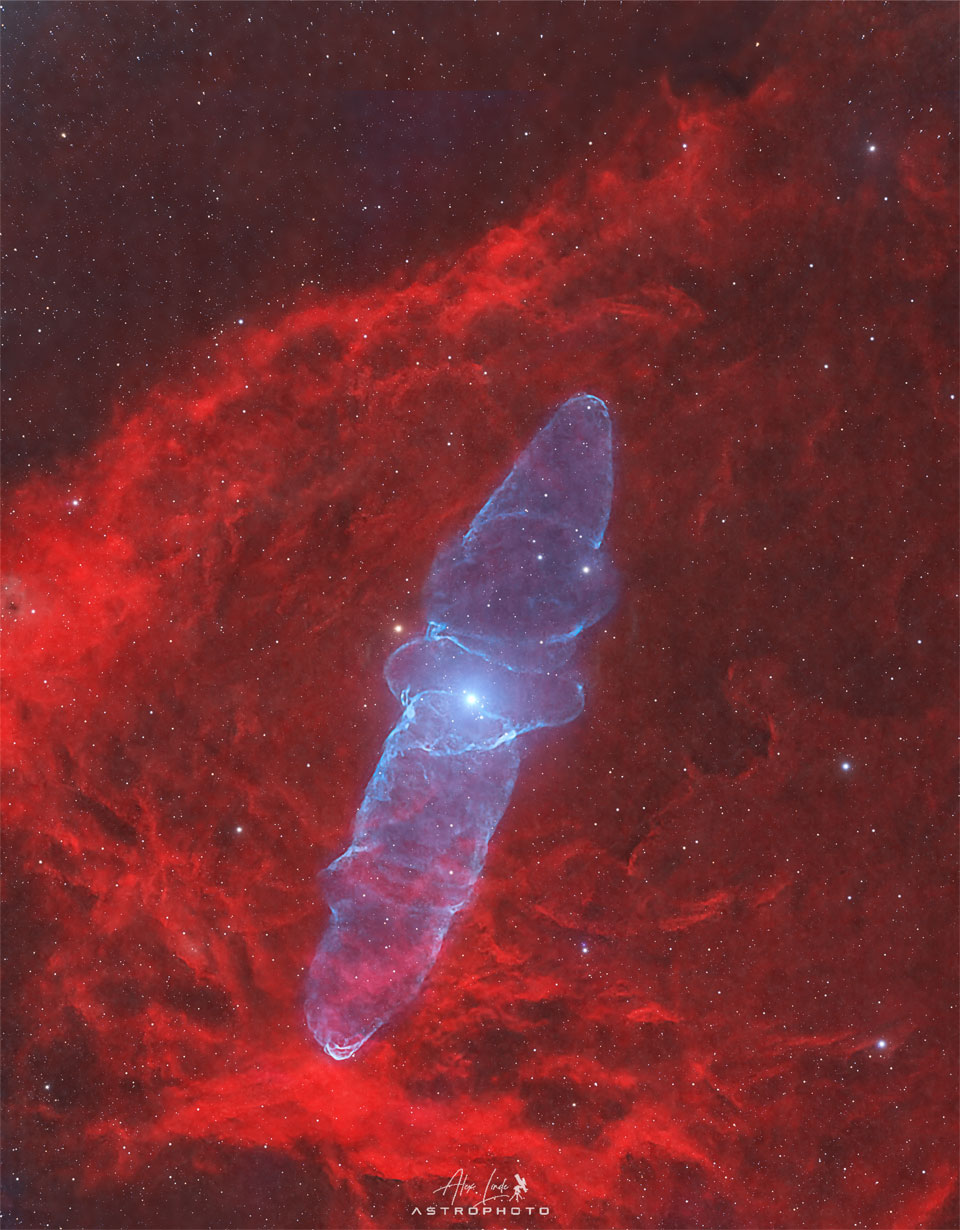17. June 2024
Ou4:大花枝星雲

探索宇宙1!逐工會揀一幅無仝款 ê 影像抑是相片,𤆬你熟似咱這个迷人 ê 宇宙,閣有專業天文學者2為你3解說4。
- 原始文章:Ou4: The Giant Squid Nebula
- 影像來源 kah 版權:Alex Linde
- 台文翻譯:An-Li Tsai (NSYSU)
[漢羅] Ou4:大花枝星雲
地球 ê 花枝無遮爾大隻啦! 這个星雲是一隻神祕 ê 花枝形宇宙雲,伊 tī 天頂足暗、嘛足大–ê。 這幅圖 是 kā 30 點鐘久 ê 狹頻影像資料組合出來–ê,大細差不多是 3 粒 月娘 遐爾闊,就 tī 皇家星座 仙王座 遐。 大花枝星雲是法國 ê 天文攝影師 Nicolas Outters tī 2011 年發現–ê。 這是 伊發現 ê 第四个天體,所以才會號做 Ou4。 伊 ê 雙極結構 有夠清楚,是雙電離酸素原子 發出 ê 青藍色 發射線。 因為大花枝星雲去予紅色 ê 水素 發射線區 包 tī 內底,所以伊真正 ê 距離 kah 特性才會 遮爾歹量。 最近 ê 研究 認為講,Ou4 應該是 tī 發射星雲 Sh2-129 內底,差不多是 2300 光年遠。 照這个推論,這隻宇宙大花枝可能是一个壯觀 ê 噴流,是 ùi 星雲中心彼个高溫、大質量 ê 三星系統 HR8119 噴出來–ê。 若真正是按呢,這隻實在有夠大隻 ê 花枝星雲,應該是比 50 光年 閣較長。
[POJ] Ou4: Tōa-hoe-ki seng-hûn
Tē-kiû ê hoe-ki bô chiah-nī tōa-chiah lah! Chi̍t-ê seng-hûn sī chi̍t-ê sîn-pì ê hoe-ki hêng ú-tiū hûn, i tī thiⁿ-téng chiok àm, mā chiok tōa--ê. Chit-pak-tô͘ sī kā 30 tiám-cheng kú ê e̍h-pîn iáⁿ-siōng chu-liāu cho͘-ha̍p chhut-lâi--ê, tōa-sè chha-put-to sī 3 lia̍p goe̍h-niû hiah-nī khoah, to̍h tī hông-ka seng-chō Sian-ông-chō hiah. Tōa-hoe-ki seng-hûn sī Hoat-kok ê thian-bûn liap-iáⁿ-su Nicolas Outters tī 2011 nî hoat-hiān--ê. Che sī i hoat-hiān ê tē sì ê thian-thé, só͘-í chiah ē hō chò Ou4. I ê siang-ke̍k kiat-kò͘ ū-kàu chheng-chhó͘, sī siang tiān-lī sàng-sò͘ goân-chú hoat--chhut ê chhiⁿ-nâ-sek hoat-siā-sòaⁿ. In-ūi Tōa-hoe-ki seng-hûn khì hō͘ âng-sek ê chúi-sò͘ hoat-siā-sòaⁿ-khu pau tī lāi-té, só͘-í i chin-chiàⁿ ê kū-lî kah te̍k-sèng chiah ē chiah-nī phái niû. Chòe-kīn ê gián-kiù jīn-ûi kóng, Ou4 èng-kai sī tī hoat-siā-seng-hûn Sh2-129 lāi-té, chha-put-to sī 2300 kng-nî hn̄g. Chiàu chit-ê thui-lūn, chit-chiah ú-tiū tōa-hoe-ki khó-lêng sī chi̍t-ê chòng-koan ê phùn-liû, sī ùi seng-hûn tiong-sim hit-ê ko-un, tōa-chit-liōng ê saⁿ-chhiⁿ hē-thóng HR8119 phùn--chhut-lâi--ê. Nā chin-chiàⁿ sī án-ni, chit-chiah si̍t-chāi ū-kàu tōa-chiah ê hoe-ki seng-hûn, èng-kai sī pí 50 kng-nî koh-khah tn̂g.
[KIP] Ou4: Tuā-hue-ki sing-hûn
Tē-kiû ê hue-ki bô tsiah-nī tuā-tsiah lah! Tsi̍t-ê sing-hûn sī tsi̍t-ê sîn-pì ê hue-ki hîng ú-tiū hûn, i tī thinn-tíng tsiok àm, mā tsiok tuā--ê. Tsit-pak-tôo sī kā 30 tiám-tsing kú ê e̍h-pîn iánn-siōng tsu-liāu tsoo-ha̍p tshut-lâi--ê, tuā-sè tsha-put-to sī 3 lia̍p gue̍h-niû hiah-nī khuah, to̍h tī hông-ka sing-tsō Sian-ông-tsō hiah. Tuā-hue-ki sing-hûn sī Huat-kok ê thian-bûn liap-iánn-su Nicolas Outters tī 2011 nî huat-hiān--ê. Tse sī i huat-hiān ê tē sì ê thian-thé, sóo-í tsiah ē hō tsò Ou4. I ê siang-ki̍k kiat-kòo ū-kàu tshing-tshóo, sī siang tiān-lī sàng-sòo guân-tsú huat--tshut ê tshinn-nâ-sik huat-siā-suànn. In-uī Tuā-hue-ki sing-hûn khì hōo âng-sik ê tsuí-sòo huat-siā-suànn-khu pau tī lāi-té, sóo-í i tsin-tsiànn ê kū-lî kah ti̍k-sìng tsiah ē tsiah-nī phái niû. Tsuè-kīn ê gián-kiù jīn-uî kóng, Ou4 ìng-kai sī tī huat-siā-sing-hûn Sh2-129 lāi-té, tsha-put-to sī 2300 kng-nî hn̄g. Tsiàu tsit-ê thui-lūn, tsit-tsiah ú-tiū tuā-hue-ki khó-lîng sī tsi̍t-ê tsòng-kuan ê phùn-liû, sī uì sing-hûn tiong-sim hit-ê ko-un, tuā-tsit-liōng ê sann-tshinn hē-thóng HR8119 phùn--tshut-lâi--ê. Nā tsin-tsiànn sī án-ni, tsit-tsiah si̍t-tsāi ū-kàu tuā-tsiah ê hue-ki sing-hûn, ìng-kai sī pí 50 kng-nî koh-khah tn̂g.
[English] Ou4: The Giant Squid Nebula
Squids on Earth aren't this big. This mysterious squid-like cosmic cloud spans nearly three full moons on planet Earth's sky. Discovered in 2011 by French astro-imager Nicolas Outters, the Squid Nebula's bipolar shape is distinguished here by the telltale blue emission from doubly ionized oxygen atoms. Though apparently surrounded by the reddish hydrogen emission region Sh2-129, the true distance and nature of the Squid Nebula have been difficult to determine. Still, one investigation suggests Ou4 really does lie within Sh2-129 some 2,300 light-years away. Consistent with that scenario, the cosmic squid would represent a spectacular outflow of material driven by a triple system of hot, massive stars, cataloged as HR8119, seen near the center of the nebula. If so, this truly giant squid nebula would physically be over 50 light-years across.
詞彙學習
| 漢羅 | POJ | KIP | 華語 | English |
|---|---|---|---|---|
| Ou4 | O U sì | O U sì | Ou4 | Ou4 |
| 大花枝星雲 | Tōa-hoe-ki seng-hûn | Tuā-hue-ki sing-hûn | 巨烏賊星雲 | the Giant Squid Nebula |
| 雙極 | siang-ke̍k | siang-ki̍k | 雙極 | bipolar |
| 狹頻 | e̍h-pîn | e̍h-pîn | 窄頻 | narrowband |
| 仙王座 | Sian-ông-chō | Sian-ông-tsō | 仙王座 | Cepheus |
| 水素 | chúi-sò͘ | tsuí-sòo | 氫 | hydrogen |
| 酸素 | sàng-sò͘ | sàng-sòo | 氧 | oxygen |
| 雙電離酸素原子 | siang tiān-lī sàng-sò͘ goân-chú | siang tiān-lī sàng-sòo guân-tsú | 雙電離氧原子 | doubly ionized oxygen atom ([O III]) |
| 發射星雲 | hoat-siā-seng-hûn | huat-siā-sing-hûn | 發射星雲 | emission nebula |
| Sh2-129 | S-H-jī it-jī-kiú | S-H-jī it-jī-kiú | Sh2-129 | Sh2-129 |
| 三星系統 | saⁿ-chhiⁿ hē-thóng | sann-tshinn hē-thóng | 三星系統 | triple system |
| HR8119 | HR pat-it-i̍t-kiú | HR pat-it-i̍t-kiú | HR8119 | HR8119 |
| 噴流 | phùn-liû | phùn-liû | 噴流 | outflow |